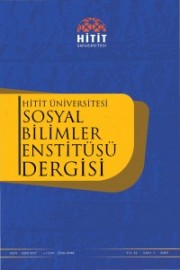SÜRÛRÎ’NİN HEZLİYYÂTININ “TEVÂRİH” BÖLÜMÜNDEN TARİHÎ YANSIMALAR
HISTORICAL REFLECTIONS FROM “TEVÂRIH” PART OF SÜRÛRÎ'S HEZLIYYÂT
Author(s): Elif Ayan NizamSubject(s): Cultural history, Comparative Study of Literature, Turkish Literature, 18th Century, 19th Century, Theory of Literature
Published by: Hitit Üniversitesi Sosyal Bilimler Enstitüsü
Keywords: Sürün; Hezliyyât (Humour); 18th Century; Divan Poetry; Chronogram; Ebced;
Summary/Abstract: Numerology or ebced refers to numerical values given to the letters of the Arabic language. Ebced has been used by Muslims in many fields of daily life. One of such uses is chronogram. Chronogram is mostly employed by Arab, Persian and Turkish poets in order to show their ability. Although it is widely argued that divan literature is strictly separated from society and social events, the use of chronograms indicate the opposite view. Divan poems were mostly writtenfor social events such as birth, death, accession to the throne, war, peace, victory, dismissal or appointment, marriage, sünnet, fıre, puberty and execution. 'They were also written for construction or maintenance of palaces, fountains, public baths, and mosques. One of the divan poets known for his significant ability in chronogram is Sürün. He lived at the end of the 18th century and at the beginning of the 19th century. There are many historical poems in his works, namely Dîvân, Hezliyyât and 'Tarih Mecmu'asi (Journal of History). In Hezliyyât, the section named “Tevârih” is made of 120 verses all of which are about history.
Journal: Hitit Üniversitesi Sosyal Bilimler Enstitüsü Dergisi
- Issue Year: 5/2012
- Issue No: 2
- Page Range: 67-86
- Page Count: 20
- Language: Turkish

